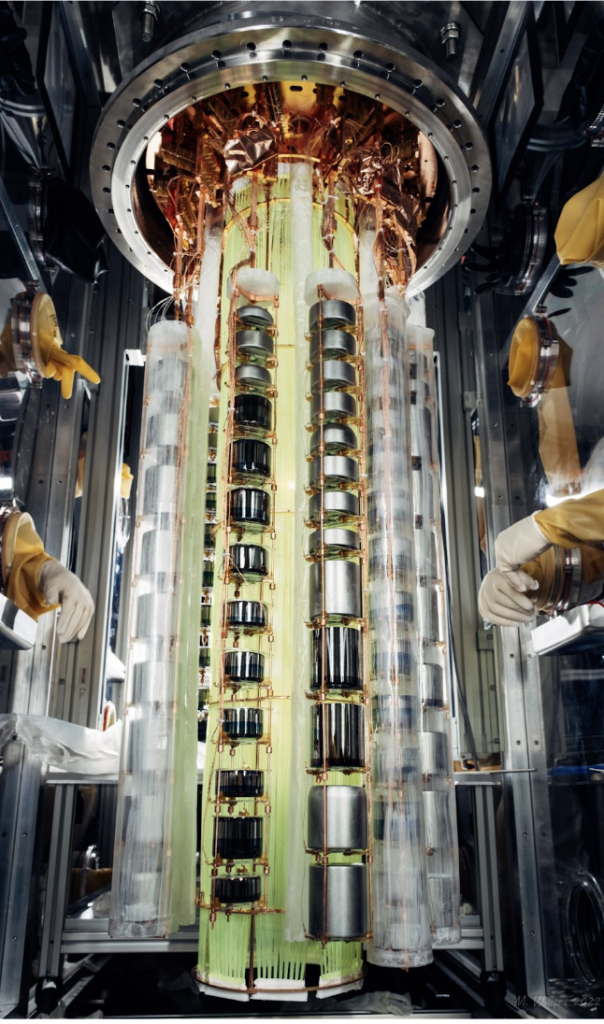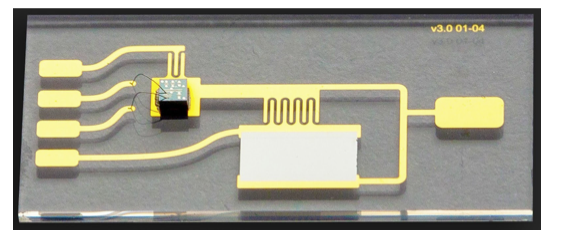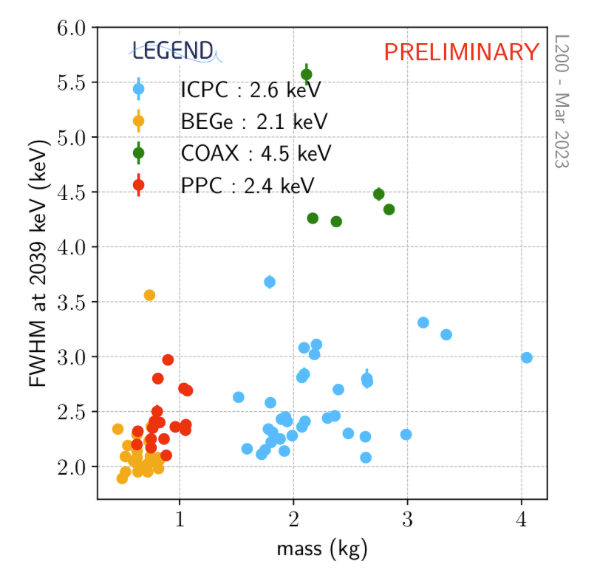
The first phase of the LEGEND experimental program — LEGEND-200 — has entered its production data-taking phase recently.
The LEGEND project was the amalgamation of two demonstrator experiments — GERDA in Europe and the MAJORANA DEMONSTRATOR (MJD) in the US — into a next-generation tonne-scale neutrinoless double-beta decay (0νββ) experiment. Its first phase, LEGEND-200, reuses the GERDA cryostat in Hall A of the Laboratori Nazionali del Gran Sasso (LNGS) underground laboratory in Italy to house 200 kg of 76Ge-enriched high-purity germanium (HPGe) detectors. Its sensitivity to 76Ge half-life is expected to be over 1027 years. Fig. 1 shows the partially completed array of 76Ge HPGes in LEGEND-200. The second phase, LEGEND-1000, will extend the discovery sensitivity tenfold to over 1028 years with approximately one tonne of 76Ge-enriched detectors. LEGEND-1000 will explore the hitherto uncharted inverted mass-ordering territory of the neutrino mass. NSD is responsible for producing and delivering the signal readout electronics for LEGEND-200. The NSD team adapted the design of the MJD low-mass front-ends (LMFE) [1] for their operation in liquid argon and built ancillary electronics to control their operation outside the cryostat. Scientists from the Università degli Studi di Milano and INFN Milano led the development and production of the charge-sensitive amplifier that augments the LMFE operation in liquid argon.
Fig. 2 shows an LMFE, which is installed adjoining an HPGe detector to increase the fidelity of its minuscule signal. The LMFEs’ proximity to the HPGe detectors places severe radiopurity constraints; they must also operate reliably with low power consumption in liquid argon. Besides a bare junction field effect transistor on its substrate board, there is no other active electronics component on the LMFE.

Preliminary calibration results of LEGEND-200 demonstrate the superior performance of the HPGe readout electronics system. Fig.3 shows the energy resolution (measured as full-width-at-half-max) at the 0νββ signal energy of 2039 keV for different types of HPGe detectors at various masses. The readout system’s performance is on par with those HPGe detectors used in MJD (red data points labeled as “PPC” in the figure) [2], improves on the “BEGe” and “COAX” detectors used in GERDA (orange and green data points) [3] while demonstrating good performance of the larger “ICPC” detectors, the baseline HPGe detector type for LEGEND-1000.

The LBNL LEGEND-200 team includes research scientist Alexey Drobizhev, project scientist Bjoern Lehnert, senior staff scientist Alan Poon, and postdoctoral fellow Ann-Kathrin Schuetz from NSD; and engineers Rebecca Carney and Marcos Turqueti from the Engineering Division.
[1] The Majorana Demonstrator readout electronics system, N. Abgrall et al., JINST 17 (2022) 05, T05003, DOI:10.1088/1748-0221/17/05/T05003.
[2] Final Result of the MAJORANA DEMONSTRATOR’s Search for Neutrinoless Double-β Decay in 76Ge, I.J. Arnquist et al., Phys. Rev. Lett. 130 (2023), 062501, DOI:10.1103/PhysRevLett.130.062501.
[3] Final Results of GERDA on the Search for Neutrinoless Double-β Decay, M. Agostini et al., Phys. Rev. Lett. 125 (2020) 252502, DOI: 10.1103/PhysRevLett.125.252502.